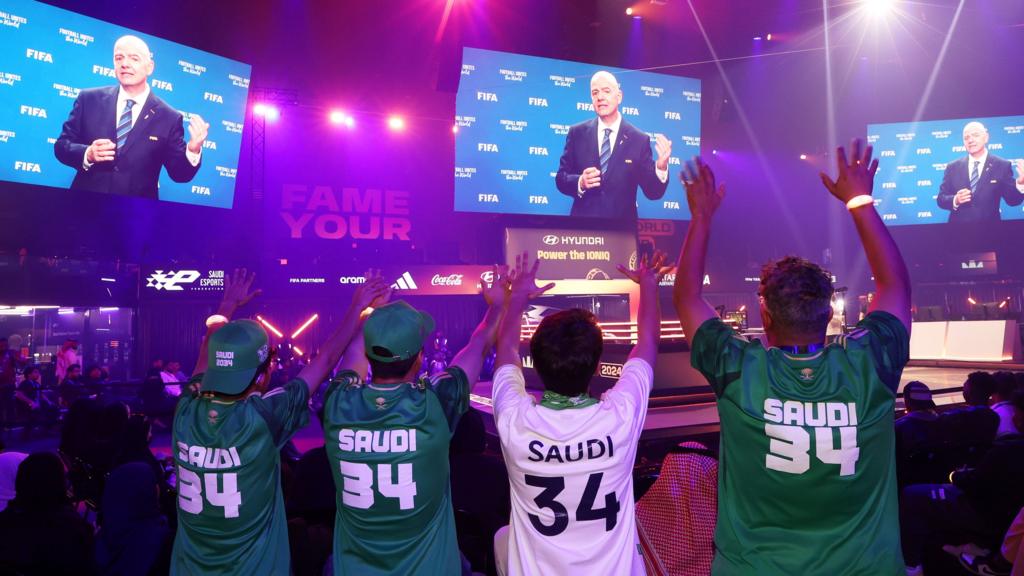The 2025 Club World Cup’s dramatic transformation owes much to the substantial financial backing of Saudi Arabia’s Public Investment Fund (PIF).
Saudi Arabia’s investment is fundamental to the revamped tournament.
However, the kingdom’s involvement in a previously underperforming event raises questions. Critics cite concerns about its impact on player welfare, domestic league balance, and the environment.
For insights into the dynamics at play, Miami’s Hard Rock Stadium offers a compelling starting point. Real Madrid’s opening match, featuring new signing Trent Alexander-Arnold, underscores the tournament’s elevated financial stakes.
Real Madrid’s reported £8m payment to Liverpool for Alexander-Arnold’s early release highlights the significant financial incentives.
A $1bn (£750m) prize pot, with potential winnings of up to £97m for top European teams, raises concerns about distorting domestic leagues and competitive fairness.
Real Madrid’s opponent, Al-Hilal, owned by the PIF, further exemplifies the kingdom’s influence. The PIF’s involvement extends beyond team ownership.
In December, DAZN secured the tournament’s global broadcast rights for $1bn, committing to free live streaming. This was surprising given FIFA’s prior struggles to find broadcast partners and DAZN’s substantial recent losses.
Shortly after, a PIF subsidiary acquired a minority stake in DAZN for $1bn, citing an opportunity to expand DAZN’s reach globally.
The PIF’s influence solidified further with its official partnership of the event, a move FIFA president Gianni Infantino hailed as a step towards globalizing football.
The PIF stated the sponsorship demonstrated its commitment to football’s growth and its role in the kingdom’s transformation. However, FIFA’s initial struggles to attract sponsors and sluggish ticket sales, compounded by a complex qualification system excluding teams like Liverpool and Barcelona, raise questions.
The expansion from seven to 32 teams prompted a legal challenge from the international players’ union and European leagues, who allege their concerns about calendar congestion and player workload have been ignored, despite FIFA’s denials.
Your guide to the 2025 Club World Cup
Fan perspectives on the Club World Cup
NZ’s challenge against European giants
Days after FIFA’s DAZN deal, Saudi Arabia was awarded the 2034 World Cup. This timeline fuels speculation about a link between Saudi investment in the Club World Cup and the World Cup bid.
Despite concerns over Saudi Arabia’s human rights and environmental record, their World Cup bid faced no competition. Australia withdrew, suggesting the process was predetermined.
FIFA defended the accelerated process, which critics deemed opaque and favoring Saudi Arabia due to a decision to restrict bids to Asia and Oceania. The Saudi bid received a record high evaluation score and was ratified by acclamation, with only Norway abstaining and criticizing the process.
Despite concerns about image enhancement, Infantino defended Saudi Arabia’s hosting, claiming it could catalyze social improvements. FIFA maintains the process was fair and transparent.
However, critics remain unconvinced. Nicholas McGeehan of Fair Square, alleges the process ensured Saudi Arabia’s selection.
McGeehan points to the commercially unusual DAZN broadcasting deal and the PIF’s subsequent investment, suggesting a link that FIFA attempts to downplay. He argues that a fair and transparent bidding process would have avoided this scrutiny.
Sepp Blatter, Infantino’s predecessor, echoes these sentiments, claiming the Club World Cup overburdens the international calendar and that Saudi Arabia effectively controls international football.
FIFA refutes claims of single-country investment, citing nine sponsors and strong commercial momentum. They emphasize their global development mandate and the tournament’s benefits, including prize money and a $250m solidarity program. FIFA also denies responsibility for calendar congestion.
This video can not be played
What is the Club World Cup?
DAZN’s emerging markets CEO, Pete Oliver, defends the investment, highlighting its commercial viability and potential to establish DAZN as a global football platform. He projects record streaming numbers and strong regional interest.
Oliver dismisses speculation about PIF’s investment being manipulative, emphasizing DAZN’s independence and the investment’s focus on the Middle East and North Africa region.
While PIF declined comment, sports business expert Callum McCarthy suggests the DAZN investment aims to create a Saudi-based sports broadcaster rivaling Qatar’s beIN Sports. He sees mutual benefit for all parties involved.
An anonymous senior FA source describes the relationship as a “marriage of convenience,” suggesting Saudi Arabia’s World Cup hosting was likely regardless of Club World Cup backing. The source views Saudi’s financial support as a FIFA bailout rather than a planned strategy.
The source highlights the potential for the Club World Cup to boost Saudi Arabia’s football image ahead of the 2034 World Cup and attract players to the Saudi Pro League, potentially addressing low domestic attendance.
Al-Ahli’s place in the 2029 Club World Cup further underscores this ambition.
Sources close to the Saudi government emphasize economic growth opportunities and the use of football to boost tourism and modernization efforts.
They support Infantino’s vision of a potentially doubled football GDP through development in the US and Saudi Arabia, reducing reliance on European football. This explains FIFA’s reported consideration of a 48-team Club World Cup in 2029.
DAZN’s Oliver expresses enthusiasm for this expansion, contingent on maintaining high team quality.
However, player unions express concerns about player burnout, and environmental groups oppose the significant expansion in matches and locations.
Ultimately, the Club World Cup’s trajectory reveals the extent of football’s potential expansion and the willingness to embrace such significant change.
FIFA Club World Cup preview
Club World Cup fixtures

